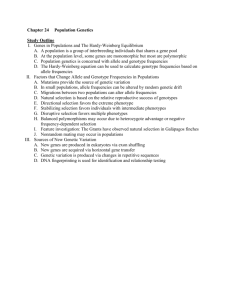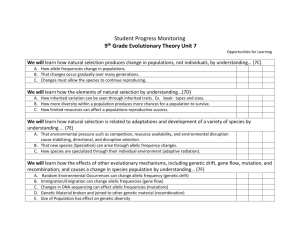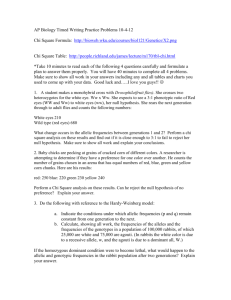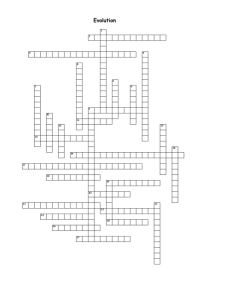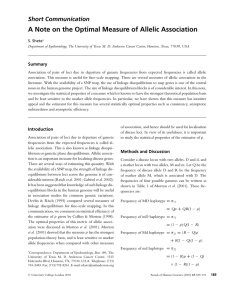Name: Biology Evolution Formal Lab http://www.mhhe.com/biosci
advertisement
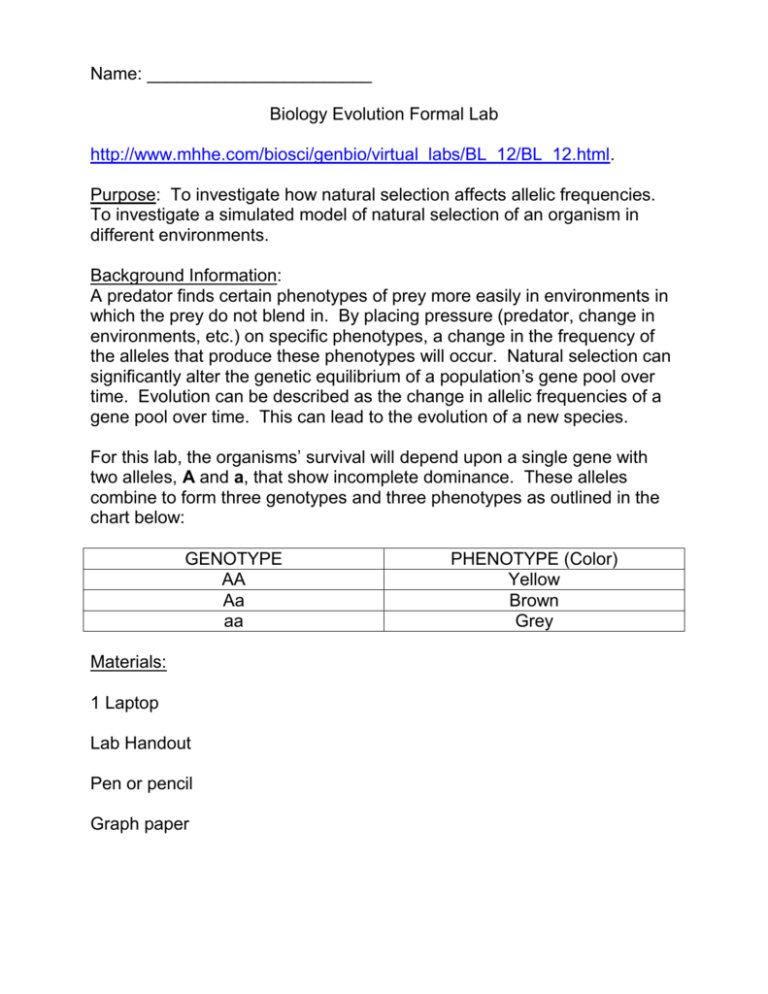
Name: _______________________ Biology Evolution Formal Lab http://www.mhhe.com/biosci/genbio/virtual_labs/BL_12/BL_12.html. Purpose: To investigate how natural selection affects allelic frequencies. To investigate a simulated model of natural selection of an organism in different environments. Background Information: A predator finds certain phenotypes of prey more easily in environments in which the prey do not blend in. By placing pressure (predator, change in environments, etc.) on specific phenotypes, a change in the frequency of the alleles that produce these phenotypes will occur. Natural selection can significantly alter the genetic equilibrium of a population’s gene pool over time. Evolution can be described as the change in allelic frequencies of a gene pool over time. This can lead to the evolution of a new species. For this lab, the organisms’ survival will depend upon a single gene with two alleles, A and a, that show incomplete dominance. These alleles combine to form three genotypes and three phenotypes as outlined in the chart below: GENOTYPE AA Aa aa Materials: 1 Laptop Lab Handout Pen or pencil Graph paper PHENOTYPE (Color) Yellow Brown Grey Procedure: 1. Select the Initial Allelic Frequencies of A and a and an environment. The number of organisms of each genotype will be displayed on the screen. Record the numbers in the data table below. 2. Click the Natural Selection Button to show the number of organisms of each genotype that survive after natural selection has taken place. The display will also show how natural selection has affected allelic frequencies. 3. Click a Generation Button, in order, from G1 through G5, to display 100 organisms in the proportions representing the new allelic frequencies after natural selection has occurred in the previous generation. 4. Collect and record data on allelic frequency changes due to natural selection in the population over five generations. 5. Use the Reset Button to collect data with different initial allele frequencies or different environments. 6. Repeat the simulation using a different Environment. Design Set-Up: Draw or take a picture of the organisms and their habitat as they appear on the screen and label all components. Trial 1: Environment: ____________________________ Hypothesis: The phenotype that will survive best in this environment will be _____________________ because _______________________________ ___________________________________________________________ . Population Data: Allele Frequency A a Generation 1 G2 G3 G4 G5 Population Data (After Surviving Numbers) AA Initial Pop. Size G1 After G2 After G3 After G4 After G5 After Aa aa Trial 2: Environment 2: ____________________________ Hypothesis: The phenotype that will survive best in this environment will be _____________________ because _______________________________ ___________________________________________________________ . Population Data: Allele Frequency A a Generation 1 G2 G3 G4 G5 Population Data (After Surviving Numbers) AA Initial Pop. Size G1 After G2 After G3 After G4 After G5 After Aa aa Analysis: Graph your population numbers for each environment. Graphs can either be completed on graph paper and attached to your lab or on the computer. Write a paragraph (we have been working on this skill throughout the year) describing the data and trends in the graphs. Conclusions: State whether the hypotheses were accepted or rejected based on the data. Use specific numbers from the data to support this. Discuss how this lab simulated what happens in nature with the evolution of organisms. Summarize the process of natural selection (give examples) and discuss the pros and cons of this lab. How could this lab be improved? Why is it important to understand these concepts? Vocab to consider: - Natural selection - Fitness - Evolution - Species - Speciation - Reproduction - Mutation - Allele - Genotype - Phenotype - Speciation - Gene pool - Selection pressures - Predator/Prey - Camouflage Works Cited: Put on separate page. Title centered on page. Biggs, A., et. Al. Biology: The Dynamics of Life. New York: Glencoe Science, 2004. http://www.mhhe.com/biosci/genbio/virtual_labs/BL_12/BL_12.html. (2014).



